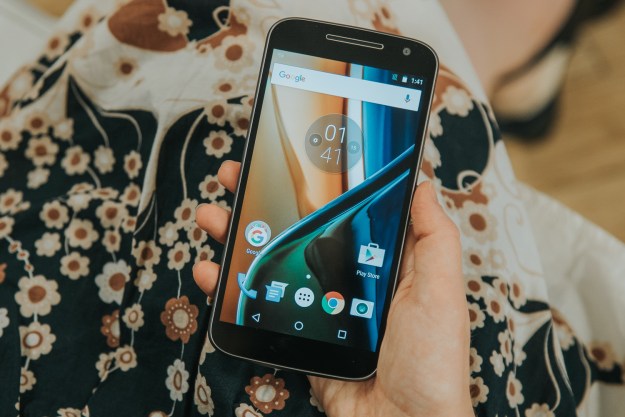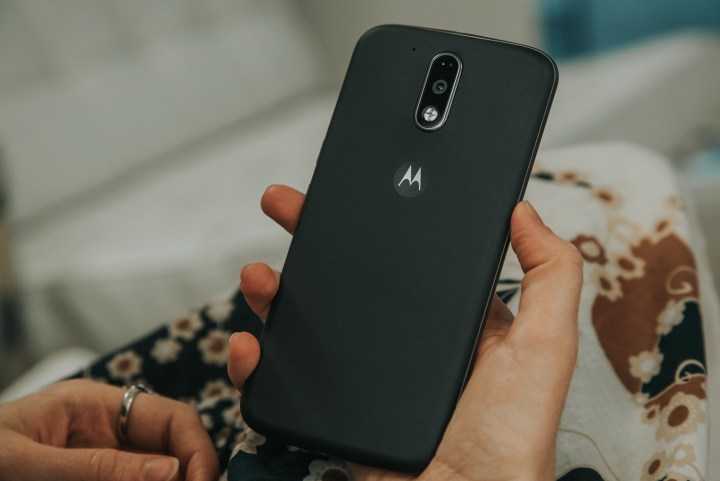
- Solid build quality
- Speedy processor
- Unobtrusive software
- Bargain price
- Outstanding 4GB of RAM
- Average camera
- No NFC
- Flimsy buttons
The label “budget phone” is misleading. There’s a tendency to assume that “budget” phones must cut major corners that their high-end counterparts don’t, or must exhibit some unforgiveable flaw that is absent in more expensive phones. But these days, it just isn’t true. Budget phones like the Nexus 5X sport fingerprint sensors and fantastic cameras. Others, like the OnePlus X and Honor 5X, sport cutting-edge silicon and attractive finishes. Affordable, cutting-edge phones are becoming the norm, not the exception.
Last year’s Moto G, ranked among the highest on the spectrum for its waterproof construction, 13-megapixel camera, and use of Moto Maker, Motorola’s online customization engine. This year, like clockwork, a new Moto G was unveiled to the world, but under far different circumstances: Motorola is now owned by Chinese electronics conglomerate Lenovo and positioned as its “premium” brand. As a result, the product language is different — the new Moto G’s known as the “G4.” Regardless, I’m happy to report that the characteristics that made last year’s Moto G such a breakout success — i.e., its spectacular specs and bargain basement price — haven’t changed a bit.
A pleasing, comfortable design with one flaw
Honestly, it is surprising how much you can get for $250 these days.
Thanks in large part to a water-resistant plastic outer shell, the G4 Plus isn’t as hefty as some of its metal-clad competition, and is more comfortable to hold. The phone’s sloping edges practically meld into the borders of its rear casing, giving the impression of a unibody crafted from a continuous, uninterrupted block of plastic. And the border between the body and removable back is nearly imperceptible, which helps it perfectly fit in your palm.
- 1. Motorola Moto G4 Plus
The same can’t be said of the buttons on the G4 Plus. The elongated rectangle of a volume rocker and tiny power switch both feel flimsy to the touch. And somewhat worryingly, the power switch is prone to wobbling in its housing — behavior which only seemed to worsen each time it brushed up against the inside of my pants pocket. The button managed to withstand a week’s worth of abuse, but I’m concerned about how it will fare over the long term.
But buttons aside, it’s tough to find fault with the G4 Plus’s hardware. The front-facing shielding — Gorilla Glass 3, which is one generation behind Corning’s newest — feels durable. The fingerprint sensor, a squarish capacitive button that looks a bit like a blackish-silver cuff link, is responsive to the touch, if a few milliseconds slower to respond than the sensors on the Nexus 6P, 5X, and Galaxy S7. And the textured removable back cover is satisfyingly resistant to bending and bruising.
Honestly, it is surprising how much you can get for $250 these days.
We’re not calling the G4 Plus a beautiful phone, but its components pair nicely together, visually speaking. The rear-facing camera is a silver-accented evolution of the sensor on last year’s Moto G, a 16-megapixel shooter with a f/2.0 aperture that’s sandwiched between a dual LED flash and two autofocus sensors (more on those later). It has a nice minimalism to it, sitting to the right of a small cutout for the G4 Plus’s noise-canceling microphone and a nondescript indent adorned with Motorola’s signature “M” branding.
The phone’s front is not gaudy either, thankfully. The G4 Plus earpiece and 5-megapixel wide-angle front-facing camera dominate the top — Motorola has bucked the recent trend of furnishing front-facing cameras with an LED flash — and, short of the fingerprint sensor and a hole for the primary microphone, lack any sort of embellishment. That simplicity of design extends to the sides of the G4 Plus: on the top is a single 3.5mm audio jack, on the bottom is a Micro USB port, and on the left side opposite the power and volume buttons is a Micro SIM tray.
Decent processing power and battery life
Under the hood is a different story. The Moto G4 is packed to the brim with extras, most visibly a 5.5-inch LCD Full HD (1920 x 1080 pixel) display that, it’s worth noting, is a half inch larger than the panel on last year’s Moto G. The display’s viewing angles are wide — tilting it horizontally and vertically on its axes didn’t produce any obvious signs of distortion — and crucially, color reproduction seemed relatively natural to my eyes. To use a well-worn cliché: the G4 Plus screen isn’t the best I’ve seen on a mid-range smartphone, but definitely not the worst.
That same assessment applies to the G4 Plus earpiece, too, which doubles as the device’s sole speaker. It’s a bit tinny and prone to tonal distortion, but serviceable — suffice to say that in most cases, you are better off with a Bluetooth speaker or pair of headphones.
The Moto G4 Plus’s other components, much like its display and speaker, are middle-of-the-road. (Sensing a theme?) Its processor, an octa-core Qualcomm Snapdragon 617 processor paired with an Adreno 450 graphics chip, is about par for the budget phone course: it won’t run circles around the high-end competition, but it’s snappy enough for day-to-day social media and productivity tasks. It opens and closes applications quickly, handles of Instagram photo streams with relative ease, and, thanks to a generous 4GB of RAM, is rarely forced to close processes running in the background. In point of fact, the G4 Plus felt zippier and more responsive in my testing than Huawei’s Mate 8, a phone almost twice its price.
For those who like numbers, the G4 performed admirably in benchmark testing, averaging 384 in 3D Mark’s Sling Shot ES 3.0 test – far above the comparably priced Honor 5X’s score of 103. It fell short of the Nexus 5X’s 1487, but that was to be expected – the Nexus’s higher-tier Snapdragon 808 CPU, despite its age, generally manages to outclass the G4’s 617 CPU in raw computing tasks.
That performance doesn’t come at the cost of battery life. Motorola estimates that the G4 Plus’s 3,000mAh should last “an entire day,” and that is in line with what I saw. Even after lengthy morning sessions where I browsed RSS feeds, Instagram, Facebook, and Twitter in equal measure, the battery indicator rarely dipped below 50 percent before 5 p.m. YouTube videos and albums streamed from Google Play Music tended to drain it faster, predictably, but I was only able to drain it completely one of the days I tested.
When the G4 Plus did need a recharge, though, it never took long. That was thanks to an included “TurboPower” charger, which Motorola says can provide up to six hours of power in 15 minutes of charging. It is built on the same Qualcomm QuickCharge 2.0 standard supported by phones such as the Motorola’s own Nexus 6 and the HTC M8, and works just as well: G4 Plus tended to reach full charge about an hour, give or take a few minutes. That may not be as quick as some QuickCharge 3.0-compatible smartphones — those can charge up to 80 percent in 35 minutes, according to Qualcomm — but the G4 Plus costs hundreds of dollars less. And that is crucial: though fast charging has become essentially ubiquitous in high-end phones, among budget phones it is still a selling point.
A major point against the Moto G4 Plus, though, is a glaring lack of support for near-field communication, or NFC. That’s technology leveraged by services like Android Pay and Apple Pay that lets you complete transactions by tapping in-store terminals. Considering the growing popularity of contactless payment in the United States, it is an odd omission, and one that’ll no doubt grow more inconvenient as an increasing number of retailers adopt
Storage size depends on your configuration options, of course, but ranges from 16GB to 64GB. It’s expandable up to 128GB via a MicroSD card slot.
Not your typical Moto camera
The rear-facing camera packs impressive tech, and a lot of it. Perhaps most complex is a phase detection sensor, which compares the luminosity values — intensity — of the beams of light that pass around either end of the G4 Plus’s
In tandem, the two sensors lock focus exceedingly quickly. During daytime testing in New York City’s midtown, the G4 Plus swiftly honed in on the focal points of faces, buildings, and monuments in milliseconds. And in even spots with lightning not nearly as bright — i.e., deep within the bowels of Digital Trends’ office storeroom — the G4 focused just as efficiently.
And the G4 Plus’s camera shined in other areas. Well-lit outdoor shots were colorful, if lacking in contrast and tending toward the cooler end of the color spectrum, and rarely looked overexposed. Thanks partly to a high dynamic range (HDR) mode that kicks in automatically, the G4 preserved an impressive amount of detail in shadows and finely textured surfaces — a notorious tripping point for budget phone cameras.
It’s not perfect, of course. The G4 Plus’s rear sensor struggled to overcome a lingering graininess and noisiness, and in low-light environments, particularly indoors, photos frequently turned out dimmer than expected. But it’s a matter of perspective: the G4 Plus performs just as well, if not better, than budget competition like the OnePlus X. It’s not about to blow high-end handsets from Samsung and Huawei out of the water, but considering its price tag, it doesn’t have to.
There’s less to say about the decidedly simpler front-facing 5-megapixel camera. It is wide in angle, captures an adequate amount of detail in bright light, and produces surprisingly good photos at night. Though it may omit the flash and dual camera module found on Lenovo’s own Vibe S1, it is, a pretty decent selfie camera.
Moto G’s camera app is worth mention. It features the standard array of the fine-grain options like exposure, white balance, shutter speed, and ISO, resolution, and
A no-frills Android experience
The Moto G, as is typical in the case of Motorola phones, doesn’t ship with much software bloat. In fact, it delivers one of the closest experiences to no-frills, stock
Moto Display is a tweak of
The other is Moto Actions, or gesture-based shortcuts for launching apps and triggering toggles. You can quickly twist your wrist twice to launch the camera from any screen, for instance, or place your phone face down on the desk to activate “do not disturb” mode. The some of the actions work with surprising consistency — during testing, wrist flicking became my go-to method of launching the camera app — but others don’t; a Tomahawk-like chopping gesture for triggering the camera was only recognized occasionally, in my experience. But thankfully, Moto Actions, like Moto Display, can be adjusted or switched off entirely.
Moto G4 vs. G4 Plus
The differences between the Moto G4 and the Moto G4 Plus extend beyond pricing. The former trades the Moto G4 Plus’s 16-megapixel camera for a 13-megapixel equivalent, and omits the phase detection and laser autofocus. It also has half the
The G4 Plus is like many budget phones in 2016. It’s surprisingly short on compromises.
But the similarities are surprisingly plentiful. Both phones contain the same Snapdragon 617 processor and 405 GPU. Both share the same front-facing 5-megapixel sensor, too, and the same 3,000mAh battery capacity. Both are available with roughly the same internal storage — 16GB up to 64GB in the case of the G4 Plus, and 16GB – 32GB in the case of the G4. And both are available on Moto Maker in a range of configurations including eight different back coloring options.
These phones are different in two ways: performance and photography. If you’re a frequent multitasker who can’t browse the web with fewer than a dozen open tabs, you’ll come to appreciate the extra
Warranty information
The Moto G4 Plus comes with a standard 12-month warranty that covers any damage that occurs as the result of a manufacturing defect. As is the industry norm, you’re on your own when it comes to accidental damage. But Motorola offers a premium option, Motorola Care Accidental Protection, that includes coverage of additional mechanical failure and accidental damage (e.g., water damage and broken screens). It’s available for $70 for 15 months or $100 for 24 months). And separately, it offers an extended service plan for $20.
Conclusion
Ultimately, the G4 Plus is emblematic of the 2016 budget
That’s not to imply the G4 Plus is the new budget phone standard-bearer. It has its fair share of flaws, including an ever-so-slightly disappointing camera and lack of









